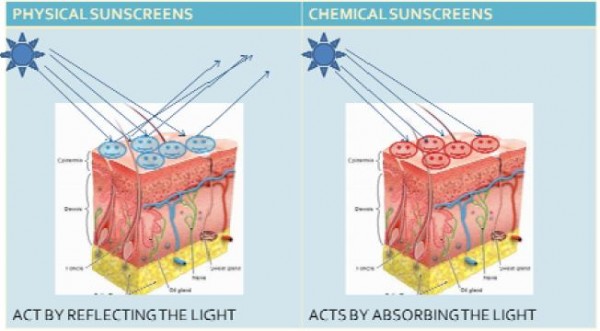Introduction
The skin is the most superficial part of the body. The signs of ageing are most visible in the skin. Although, ageing skin is not a threat to a person, it can have a detrimental effect on the psychology of a person. A look into the causes of skin ageing, the available treatments and preventive measures for this inevitable change is important to help both the already aged, as well as, the youth.
This is a 4 part article in which:
- Part 1 – Discusses the structure of skin and its different components
- Part 2 – Discusses cutaneous ageing and its causes
- Part 3 – Discusses the characteristics of ageing skin and the changes in skin appearance
- Part 4 – Discusses products and treatments for skin ageing
a) Sunscreen Agents (current article)
b) Moisturizers
c) Antioxidants
d) Make Up
e) Dermal Fillers
f) Chemical Peels
g) Botulinum Toxin
h) Estrogen and Hormonal Treatments
i) Plastic Surgery
Sunscreen Agents1,2,3
Solar radiation is composed of infrared radiations (770nm and longer wavelengths), visible light (400-770nm) and ultraviolet radiations (UV) (290-400nm). Infrared and visible light causes reddening of skin which will appear immediately and subside rapidly, and UV rays are the cause of erythema.
UV radiation is further divided into:
- UV-A range (320-400nm)- the peak being at 340nm. It causes direct tanning, photo-oxidation of melanin present in the upper layer of the skin, and are weak in producing erythema.
- UV-B range (290-320nm)- the peak being at 297.6nm. It causes sunburn as well as irritating reaction. It leads to formation of melanin and development of tan.
- UV-C range (less than 200nm). These rays are generally filtered off by the ozone layer. It is extremely damaging to tissue and can cause skin cancer, erythema but does not result in tanning.
As seen earlier, sun is the leading cause of extrinsic aging, and hence it is imperative to ameliorate this area in the skin care regimen. Sunscreen agents either act by scattering or by absorbing the sun’s radient energy. Depending on the mechanism by which they block the radiation, they are classified as physical (scatter) and chemical (absorb) sunscreens (as shown in Figure 1). The sunscreen agent is thought to prevent cellular damage and thus prevent dehydration. It may be chemical, physical, or a combination of both.
The best cosmetic a person can wear for preservation of his or her youthful appearance is a sunscreen. It can cause an apparent reversal of some photoaging and keep the skin youthful looking. Physical sunblocks are important for individuals who must be absolutely protected from the sun. They are also important to protect the most vulnerable parts of the body, such as the ears, nose tips, shoulders, and cheeks. There are several types of UVB and UVA chemical sunscreens.
Patients should avoid the sun during the peak hours of sunshine, wear protective clothing, and use sunscreens while outdoors. The constant use of a photoprotector can promote an apparent reversion of photoaging giving skin a younger aspect. A great improvement may occur with suppression of exposure or photoprotection, even when started late in life. There is a formation of neocollagen and new elastic fibers, giving the same aspect as seen in non-exposed skin.
The extent which a sunscreen product can protect from sunburn and other harmful effects of exposure to sunlight varies with individual skin type. A measure of how well a sunscreen agent can block the sun’s rays is calculated by the SPF (Sun Protection Factor) value of the sunscreen. SPF is defined as UV exposure to produce minimal erythemal dose on protected skin and the exposure that will produce the same erythema on unprotected skin. Thus the SPF formula is as follows:
Larger the SPF value, greater the protection the sunscreen can confer. An SPF-15 or above offers greatest protection from sunburning and permits no tanning.
References
- Elderly skin and its rejuvenation: products and procedures for the aging skin, Marcia Ramos‐e‐Silva et. al., Journal of Cosmetic Dermatology, 6, 40–50
- Harrys cosmeticology, J. D. Wilkinson and R. J. Moore, Longman Singapore Publishers ltd. Pg 222 ‐ 258(sunscreens and suntan oils)
- Cosmetics Formulation Manufacturing and Quality Control, P. P. Sharma, Vandana Publications pvt. Ltd. Pg 195 – 198, 183 – 185.




